New Products & Services
March 2011
The Model FS-B2510 Dual-Serial port gateway (photo) includes two serial ports and one Ethernet port for integration from serial-to-serial or serial-to-Ethernet applications. This newest addition to the firm’s gateway product line meets the needs of integrators seeking to interface a serial (RS-232 or RS-485) device to a serial or Ethernet network. Utilizing the firm’s extensive protocol library and the proven configuration capabilities, the FS-B2510 is a cost-effective solution to integrating more devices into the automation or process control network. With more data available to the network, the result is greater savings of energy and other resources. — FieldServer Technologies, Milpitas, Calif.
The Allen-Bradley SLC 500 is a small, chassis-based, modular family of programmable controllers and I/O. The SLCs smaller size means you can use an SLC in applications where you can’t afford the size and overhead of a traditional, full-sized PLC. With its multiple processor choices, numerous power supply options and extensive I/O capacity, the SLC 500 controller allows the creation of a system designed for a given application. — Rockwell Automation, Milwaukee, Wisc.
The anionic, short perfluoroalkyl chain PolyFox fluorosurfactants are formulated to meet the goals of the U.S. Environmental Protection Agency’s (EPA) Design for the Environment (DfE) program. The new products are formulated using dipropylene glycol monomethyl ether (DPM) solvent instead of diethylene glycol monobutyl ether (butyl carbitol), the solvent used previously. Some consider DPM to be an environmentally preferred formulating agent. The PolyFox technology platform is based on an oligomeric poly (oxetane) backbone with short perfluoroalkyl groups. PolyFox materials are neither prepared from PFOA, PFOS or telomer-based fluorochemicals of concern, nor can they degrade into such materials. Consequently, PolyFox fluorosurfactants and fluorochemicals by regulatory agencies globally, including the EPA and the EU’s REACH program. — Omnova Solutions, Inc., Fairlawn, Ohio
The Sendix 5006 2-in. incremental encoder features a completely stainless-steel housing and Viton seals to resist corrosion and physical abuse in harsh plant environments. The encoder can handle fluctuations in temperature, from –40 to 85°C, and is IP67-rated when sealed. The Sendix 5006 incorporates a proprietary Safety-Lock bearing assembly that has been tested to provide additional protection against vibration and installation errors. It is ideal for use in corrosive environments or for applications requiring long-term durability. — Turck Inc., Plymouth, Minn.
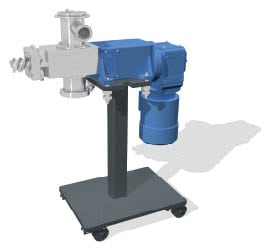
The ZS-EG twin-screw degassing unit (photo) is just one of a comprehensive group of degassing solutions for compounding and extrusion processes. The company has made a number of improvements to its ZS-EG side degassing units: The screw set has been optimized; the standard models are designed for an absolute vacuum of up to 50 mbar (lower degassing pressure upon request); and the units come with a variable speed drive as standard. Compared to an open-vent dome, the twin-screw side-degassing unit offers many advantages, including: the ability to be fitted at low-cost to a combi-barrel segment of the ZSK twin-screw extruder; deliver effective degassing, even with high air or moisture content of the bulk material, at acceptable residence times, so plant throughput can be raised by 10–15%; and improve compound quality and consistency since no material can fall back into the processing unit through the vent. Hall 14, Stand B33 — Coperion GmbH, Stuttgart, Germany
www.coperion.comThe Class 125 Cast Bronze Y-strainers (photo) are used in commercial applications to trap foreign matter in steam, water, oil or gas pipelines. The bronze strainer line includes Class 125 solder ½ – 2-in. and threaded ¼ – 3-in. rated 125 SWP and 200 CWP. They are available with the options of threaded or solder-end connections, solid cap or tapped cap with plug, and stainless steel 20 mesh or perforated stainless-steel screen. Other important features include a dezincification-resistant cast bronze body and cap, as well as machined seats in body and cap to ensure proper screen alignment. — Nibco, Inc., Elkhart, Ind.
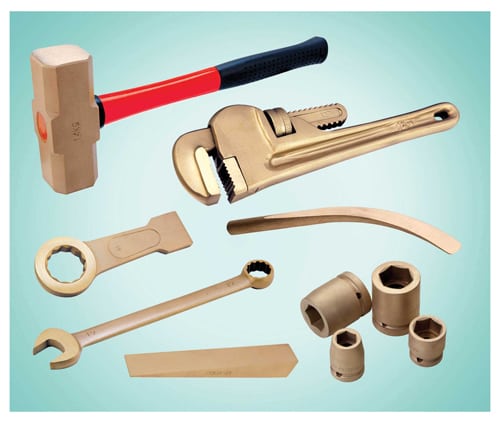 Manufactured from special aluminum-bronze or copper-beryllium alloys, these non-sparking, non-magnetic hand tools (photo) meet ATEX regulations for safe use in areas where hazardous, flammable or combustible vapors, liquids, dusts or residues may be present. This line of safety tools consists of hammers, flange wedges, striking wrenches, impact sockets, screwdrivers, shovels and other hand tools. They comply with the ATEX Directive stating that no tools that can cause sparks are permissible in Ex Zones 0, 1 and 2 (flammable gas, mists or vapors); Zones 20, 21 and 22 (combustible dusts) and M1 and M2 for mining. Each tool is laser engraved for the proper Ex Zone classifications indicating the zones for which it can be used. — CS Unitec, Norwalk, Conn.
Manufactured from special aluminum-bronze or copper-beryllium alloys, these non-sparking, non-magnetic hand tools (photo) meet ATEX regulations for safe use in areas where hazardous, flammable or combustible vapors, liquids, dusts or residues may be present. This line of safety tools consists of hammers, flange wedges, striking wrenches, impact sockets, screwdrivers, shovels and other hand tools. They comply with the ATEX Directive stating that no tools that can cause sparks are permissible in Ex Zones 0, 1 and 2 (flammable gas, mists or vapors); Zones 20, 21 and 22 (combustible dusts) and M1 and M2 for mining. Each tool is laser engraved for the proper Ex Zone classifications indicating the zones for which it can be used. — CS Unitec, Norwalk, Conn.
This manufacturer provides different kinds of bearing solutions for the chemical process industries (CPI). Full ceramic bearings consist of rings and balls made of ceramic, whereas the rings of a hybrid bearing system are made of high-value bearing steel (photo). Both bearing types have a variety of advantages over standard bearings. In particular, seizing — one of the main failure modes in standard steel bearings due to poor lubrication — is virtually impossible in full ceramic and hybrid bearings, says the manufacturer. This makes it possible to use these bearings without lubricants, and dry-running bearings drastically reduce friction and particle emissions. — Cerobear GmbH, Herzogenrath, Germany
The AL400 system is a new plasma-enhanced, chemical-vapor-deposition (PECVD) instrument designed for the deposition of a smooth coating on rubber and elastomeric surfaces. The low-coefficient-of-friction coating reduces tackiness and drag of rubber and elastomeric surfaces, and can repel lint and other contaminants on silicone components. Coating thickness is typically less than one micron, and has no effect on the bulk properties of the coated material. The PECVD system is clean-room compatible and available in a table-top version or with a free-standing enclosure. — Plasmatech Inc., Erlanger, Ky.
This firm is exhibiting its efficient, standard plasma system V6-G, which is designed as a compact device for industrial, small-series production as well as for low-pressure plasma treatment in R&D laboratories. Plasma can be used to generate ultraclean surfaces, improving higher adhesive strength of steel glued to polypropylene or for improved durability of varnish on plastics. The company is also involved in the BMBF-funded Nanodyn project, which aims to discover ideal surface conditions to reduce friction, increase reliability and improve longterm stability for ball bearings. The new concept is investigated for different kinds of bearings and lubricants. Hall 11, Stand E05 — Pink GmbH Thermosysteme, Wertheim, Germany
www.pink.deThis firm now offers custom-made tellurium powders to meet customer specifications. The powders are made from commercially pure (99.7 – 99.999%) tellurium ingots using custom mills. The powder is available in 30 to 325 mesh, or per customer requirements. Tellurium is used in a range of applications, including as additives for steel and cast iron (for increasing mechanical strength and chemical durability), and coloring agents in glass and ceramics, catalysts, herbicides and insecticides. Tellurium is also used in electrical devices (such as printers and photocopiers), and tellurium compounds are used in thermo-generators (Bi2Te3 and Sb3Te3) and solar batteries (CdTe). — Accumet Materials, Co., Ossining, N.Y.
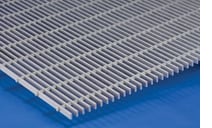 Duragrid 1-in. R-7300 fiberglass grating is specially designed to replace 1-in. steel grating in corrosive environments, such as offshore drilling and production platforms, refineries and chemical plants. It is extremely strong and impact resistant, able to span 36 in. with a load of 100 lb/ft 2 and a deflection of less than ¼ in. Virtually maintenance-free, it will not rust and corrode like steel grating, thus reducing maintenance costs. With a rectangular-bar design, it is well-suited for applications exposed to wave uplifts, or when all surfaces of the bars need to be kept clean. At half the weight of 1-in. steel grating, Duragrid is easily handled in installation, and cost less to ship than steel grating. Also, a non-skid surface on fiberglass grating is safe for workers, while having low electrical and thermal conductivity. — Strongwell, Bristol, Va.
Duragrid 1-in. R-7300 fiberglass grating is specially designed to replace 1-in. steel grating in corrosive environments, such as offshore drilling and production platforms, refineries and chemical plants. It is extremely strong and impact resistant, able to span 36 in. with a load of 100 lb/ft 2 and a deflection of less than ¼ in. Virtually maintenance-free, it will not rust and corrode like steel grating, thus reducing maintenance costs. With a rectangular-bar design, it is well-suited for applications exposed to wave uplifts, or when all surfaces of the bars need to be kept clean. At half the weight of 1-in. steel grating, Duragrid is easily handled in installation, and cost less to ship than steel grating. Also, a non-skid surface on fiberglass grating is safe for workers, while having low electrical and thermal conductivity. — Strongwell, Bristol, Va.
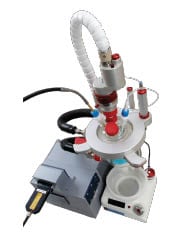
With integrated mid-infrared (IR) capabilities, the fully automated Atlas FT-IR System (photo) for reaction monitoring combines the technology of the Atlas automated reactor with Bruker Optics’ Matrix-MF, a process-ready fourier transform infrared (FT-IR) spectrometer. This system can be used to examine product yields, impurities, reaction kinetics, end points and more, with upgrades available to provide further functionality, such as reaction calorimetry, pH control, gravimetric or volumetric reagent addition, crystallization control. The system is available for a range of temperatures of –80 to 180 °C, pressures of up to 200 bar, and wavenumbers from 560 to 3,500 cm -1. — Syrris, Royston, U.K.
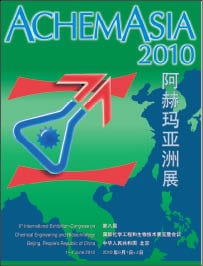
More than 400 exhibitors from 24 countries are expected to participate in AchemAsia 2010, the 8th International Exhibition-Congress on Chemical Engineering and Biotechnology (Beijing, China; June 1–4). Held every three years in Beijing for the past two decades, AchemAsia 2010 is expected to generate positive momentum and a significant boost for the chemical engineering discipline in China, says Thomas Scheuring, head of exhibition congresses, Dechema e.V. (Frankfurt, Germany; www.dechema.de). This comes at a great time, as it coincides with the substantial investment package launched by the Chinese government last year. This package, representing a volume of RMB500 billion [about $73 billion], gives testimony to the essential position of the chemical sector in the Chinese economy, and opens up excellent opportunities for suppliers to the chemical and petrochemical sector in China, says Scheuring.
The trade fair will be held in the new China National Convention Center, close to Beijings Olympic Park. Along with the exhibition, more than 80 scientific lectures will be presented during the conference program, which covers all of todays hot topics, including future feedstocks, future energy sources, water, air and mobility. In addition, a guest event — the 2010 Pharmaceutical Engineering International Forum — will take place June 2–3. Officials from the U.S. Food and Drug Administration (FDA; Washington, D.C.), the European Medicines Agency (EMEA; London), and experts from the global pharmaceutical engineering fields will be invited to the Forum, which is divided into four branch forums about validation, aseptic production, project management and GAMP 5.

The HPR Series reactors (photo) are designed for researchers interested in performing pressurized chemical reactions for synthesis or process development. The stirred reactors range in size from 50 mL to 4 L, and may be operated at up to 10,000 psi and 350C. The reactors are equipped with a magnetically coupled impeller for optimal mixing. These benchtop models are ideal for studies on catalysis, polymerization, hydrogenation, oxidation, isomerization and dehydrogenation. Supplied as ready-to-use equipment, the reactors fit into a fume hood. — Supercritical Fluid Technologies, Newark, Del.
The Bany PNIO network analyzer and the Simba PNIO module in the Simit simulation system provide operators of Profinet networks with a number of new tools for efficient monitoring and simulation. Bany PNIO (bus analysis Profinet I/O) enables reaction-free, realtime analysis of data traffic at rates up to 1 Gbit/s and a resolution of 10 ns. The Simba PNIO simulates up to 256 devices on the controller in real time. Mixed operation of real and simulated devices is also possible, which makes it easier to expand facilities and accelerates their commissioning. Both units are based on the same hardware platform, so Simba PNIO can be used in simulation hardware in the engineering and test phases of an installation, and can then continue to be used in the subsequent plant operation as a Bany PNIO network analyzer after payment of an additional license fee. — Siemens Industrial Solutions, Erlangen, Germany
This firm now offers a free DMT (Device Type Manager) for its 12300 Series Hart Digital Level Transmitter/Controller (photo). This new DMT allows users of the firm’s digital instruments to access user-friendly field-device tool (FDT/DMT) technology, and adds to the existing library of device descriptions (DDs) available for digital products, and provides customers with a user-friendly and integrated FDT for setup, commissioning and diagnosing. This DMT is designed according to the latest FDT specification 1.2, and is tested with the dtmInspector software, allowing interoperability with all FDT-certified frame applications, such as PACTware, Fieldcare and Fieldmate. — Dresser Masoneilan, Courbevoie, France
ChemShow 2009 will be held November 17-19 at the Jacob Javits Convention Center in New York. “Processing Solutions for a Changing Marketplace,” the show will showcase over 300 exhibitors and anticipates more than 10,000 professional attendees.
ChemShow 2009 will feature a technology conference and symposium on nanoscale materials and “green” technology. Organizers say the focal point of the symposium will be bridging the gap between science, technology and commercialization. Created for the ChemShow by Innovative Research and Products (iRAP; Stamford, Conn.), the “Nano and Green Conference & Symposium” will explore the impact of nanotechnology on environmentally friendly processing. The conference will focus on colloids and surface modifications that benefit nanotechnology applications, nanoparticle synthesis and nano-bio convergence and their emerging technologies and markets.
Aside from the product exhibition and symposium, the show features a host of educational sessions. Chemical Engineering will present a two-day educational program (see pp. 30-31).The Valve Manufacturers Association (VMA; Washington, D.C.) will present sessions on the use of valves and actuators in the chemical process industries (CPI). A number of sessions are offered as part of AIChE Day (American Institute of Chemical Engineers; New York) at the Chem Show. Among the offerings is a tutorial session on the fundamentals of powder flow technology, which will seek to provide insight into common flow problems of solids. Other AIChE sessions include mixing basics, troubleshooting pneumatic conveying systems, sustainability practices, process safety and others. Additional information about the show can be found at http://www.chemshow.com.
During the show, look for Chemical Engineering’s exclusive coverage of the ChemShow in its daily newspaper. Those attending the show are also encouraged to visit Chemical Engineering at Booth 703. Among the ChemShow exhibitors are the following:
In testing, this blast-resistant storage unit (photo) remained structurally undamaged following a 5-psi, 500-ms-duration blast generated by a high-explosive, ammonium-nitrate fuel-oil charge at a standoff distance of 110 ft. The module is designed for worker safety in the petrochemical, chemical processing and construction industries. Booth 827 — A Box 4 U, Wichita, Kan.
As at Achema 2009, the theme of this engineering-and-construction firm’s AchemAsia exhibition stand will be “The power of the new.” The company’s employees invest all their energy in developing new ideas and process technologies that enable customers around the world to use raw materials and energy sources more efficiently and cost-effectively than before. Eight lectures will be presented during the conference, including coverage of: new developments in lactic acid technology; Prenflo coal gasification for coal-to-liquids and IGCC; innovative heat integration; plant solutions to use raw materials and energy sources more efficiently; and more. Stand 27J — Uhde GmbH, Dortmund, Germany
www.uhde.eu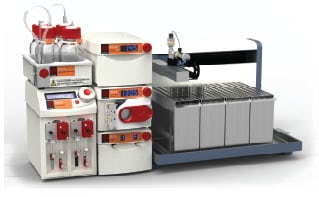
Launched last November at the First RSC/SCI Symposium on continuous processing and flow chemistry, the Asia range of flow chemistry systems (photo) is scalable and modular. Commercially available next February, the Asia system covers wide temperature (–15 to 300°C) and pressure (0–20 bars) ranges, and safely provides accurate temperature control. With fast reaction times and microgram to kilogram scalability, its design enables manual or automated operation with optional PC control. — Syrris Ltd., Royston, U.K.
www.syrris.comPCMS and Track, two cost-control software packages used in petroleum refining, chemical and petrochemical industries, have joined forces. Management Controls, Inc., the owner of Track, has acquired PCMS (Project Control Management System). Users will soon benefit from contractor administration and cost control provided by Track, along with the activity-based cost tracking and forecasting that PCMS provides, all in one software package. Later this year, PCMS will become Track’s Project Cost Forecasting (PCF) module. Cost control and predictability will be improved in the execution of large projects with the use of this single software program. By giving users the ability to perform paperless contractor administration and total cost functions, and to allow them to track project costs as they occur and forecast costs at completion will create new efficiencies and ensure project success. — The Turnaround Management Company, Houston, Tex.
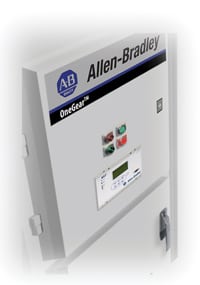
This firm has released the Allen-Bradley OneGear product line (photo) providing a full range of motor control center and power control center options. The OneGear product line is the next generation of medium-voltage motor control specifically designed for use with full voltage and solid-state, reduced voltage applications, supporting operating voltages up to 15 kV and utilizing both vacuum-contactor and circuit-breaker switching technology. All OneGear products will be available with optional arc-resistant cabinets, which meet IEEE C37.20.7 and IEC Type 2 protection. The OneGear product line offers remote monitoring, diagnostic capability and in-depth motor protection for maximum motor utilization while avoiding damage and downtime. — Rockwell Automation, Milwaukee, Wis.
Rockwell Automation
A recently introduced technology for manufacturing tantalum surface alloys offers an affordable solution for processes involving hot acids and other highly corrosive materials. The corrosion-resistant alloy can be applied to valves, fittings, instrumentation and other custom products. The process of making the alloy involves heating and reacting pure tantalum metal to produce a gaseous atmosphere of the element. The tantalum vapor creates an alloy bond with the instrument’s surface that gives corrosion-resistant properties of tantalum while maintaining the original part’s size and shape. Booth 759 — Tantaline Inc., Waltham, Mass.
http://www.tantaline.com
Scott Jenkins
The MegaMethanol and MTP (methanol-to-propylene) concepts open new routes for coal monetization, and SNG (substitute natural gas) is a possible way to convert coal into a transportable fuel — methane. SNG can be used either for power generation or routed to pipelines as an admixture to natural gas. This company is also active in the field of synthesis gas (syngas), hydrogen generation and clean conversion technologies for the production of motor fuels and chemicals. The firm is a leading technology company operating worldwide in the fields of process engineering and plant contracting. Its technology is based on proprietary and exclusively licensed technologies in the areas of gas-to-petrochemicals products via syngas or methanol or synthetic fuels, petrochemicals, petroleum-refining technology, polymers, as well as renewable resources and food. Hall 5P — Lurgi GmbH, Frankfurt, Germany
www.lurgi.com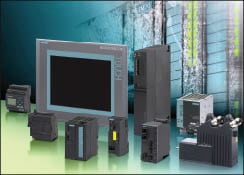
This firm has expanded the range of its Siplus extreme control and communication products (photo), which are especially suited to harsh environmental conditions. The devices are now also certified for use in toxic atmospheres (according to ISA-S71.04 GX), for offshore deployment (salt mist) and in “Arizona dust.” The components were previously suited for corrosive atmospheres (ISA-S71.04 G1, G2 and G3) as well as in situations involving 100% humidity, dewing and ice formation. — Siemens Industry Sector, Automation Div., Nueremberg, Germany
www.siemens.comA new service, called SNAP (Special Needs And Products), provides customers with customized solutions to meet unusual signal interface needs in industrial process control, system integration and factory automation applications. The SNAP service aims to fill the hole when it comes to updating instruments, replacing instruments and supplying a signal interface when an off-the-shelf instrument is not available. Typical modifications include special instrument functions, such as non-standard signal I/Os, non-standard power ranges, computing and math functions, alarm-trip modifications and so on. SNAP engineers will also work with customers to develop special and OEM instrument housings and enclosures, custom mounts and connectors and special temperature sensors and thermowells. — Moore Industries-International, Inc., North Hills, Calif.
www.miinet.com/SNAP
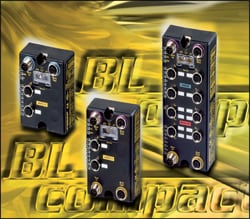 |
| Hans Turck |
This new series of compact I/O modules (photo) uses technology based on the reliable BL67 modular I/O system, and includes different BL67 electronic components and a programmable gateway within a single epoxy-sealed housing that is resistant to dirt and shock. Up to 16 digital or analog signals on one single I/O block module provide increased application compatibility and enable the user to move towards a consistently decentralized process. The IP67 stations will be available in three housing sizes and six different I/O profiles for Profibus-DP and DeviceNet. The BL compact series will soon also support all established fieldbus protocols as well as Industrial Ethernet and IO-Link. — Hans Turck GmbH & Co. KG, Muelheim an der Ruhr, Germany
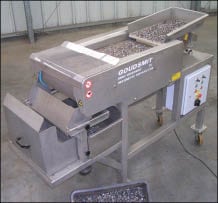
The redesigned High Gradient Separator (photo, p. 32I-7) has been developed for the recycling industry and is particularly suitable for operation in a difficult and dirty environment. The magnetic strength of the coils has been increased to 10,000 Gauss, which allows the magnetically weak iron and slightly magnetized particles to be removed from waste and residual streams. The complete system consists of a frame, a vibrating chute, a control unit, the separator and an easily adjustable splitter unit. — Goudsmitt Magnetic Systems B.V., Waalre, Netherlands
www.goudsmit-magnetics.nlThe Advanced Flow LF glass reactor is a highly flexible, low-flow glass reactor that enables a cost-effective transition to higher-volume, continuous-flow chemical processing. Like others in the product line, it continuously and efficiently streams reactants together with integrated heat exchange, but it is designed for a size suited to smaller process development. Highly engineered, glass fluidic modules form the basis of the reactor, providing mixing and heat exchange not possible in batch reactors used today. — Corning Inc., Corning, N.Y.
www.corning.com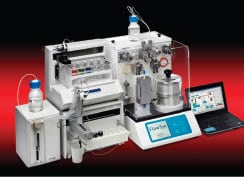
Auto-LF is an automated loop-filling module that allows flow chemists to perform multiple experiments with multiple reagents automatically. Used with for this firm’s FlowSyn range of continuous flow reactors (photo), Auto-LF enables chemists to deliver more compounds even faster. Used to prepare combinatorial libraries in Flow, FlowSyn can also perform automated experiment optimization and reagent screening. By using a separate liquid handler and fraction collector, Auto-LF allows sample loop filling for the next experiment to occur before the current experiment has finished, thereby reducing overall runtimes. — Uniqsis Ltd., Cambridge, U.K.
www.uniqsis.com